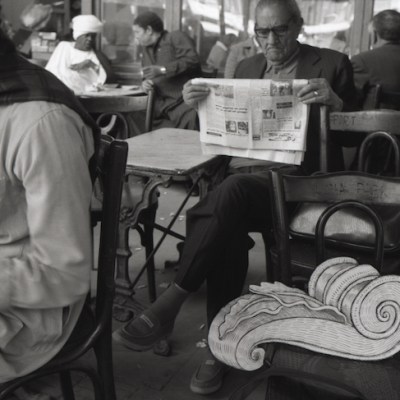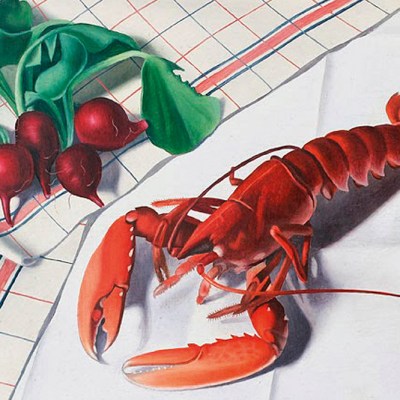From the November 2022 issue of Apollo. Preview and subscribe here.
In the window of Kulu Kulu, a conveyor-belt sushi joint on Brewer Street in London, the sushi boxes are ever tempting. There are little bricks of nigirizushi, topped with translucent slabs of tuna or shards of mackerel with iridescent skin, and makizushi rolls with batons of oshinko (pickled radish) couched in nests of clean white rice. Walls of seaweed packed with salmon roe look like tiny bathtubs brimming with orange bubbles – they might have been plucked from a Surrealist doll’s house.
As enticing as this all is, every morsel is made of plastic. The display has been in place for 30 years, the restaurant manager tells me, and only changes if the restaurant tinkers with its menu: octopus out, squid in. Sushi-making first proliferated in Japan during the early medieval period as a means of preserving fish; the rice was discarded after it had fulfilled its function in fermentation. These models show modern sushi, of course, which is usually made with fresh fish and polished rice. But they have been moulded from a resin that does not so much conserve the food as render it altogether imperishable.
It is unusual to see replica food in restaurants in London. In Japan such displays are common, particularly in affordable venues, and are by no means limited to sushi. They often include other types of Japanese food, such as tempura, yakitori or ramen, or Western fare like hamburgers or spaghetti bolognese. Chopsticks sometimes float above the plates, hands free, tousling the mounds of soba noodles.
Shokuhin sampuru (food models) have a long history in Japan. Credited with popularising them is Takizo Iwasaki (1895–1965), who in 1932 decided to set up a factory in Osaka to fabricate artificial food after he had hoodwinked his wife, it is said, with a flawless wax omelette. If they initially served as sample dishes that conveyed to restaurateurs how food ought to appear, sampuru soon took on the promotional function of luring diners into restaurants. Window displays could define imported food types for domestic consumers and illustrate Japanese cuisine for tourists stumped by kanji. Further workshops opened in Gujo as the demand for wax food models soared. Durable plastic began to usurp wax in the late 1970s.
Food replicas emerged in a culinary culture that was already disposed to display. Sushi and tempura stands began to flourish in Edo (Tokyo) in the early 19th century, the street food vendors and their offerings becoming a recognisable feature of the city. In a woodblock print from the early 1840s, Hiroshige depicts a throng of them along the waterfront at Takanawa, including a sushi seller pressing fish on to rolled rice. Later, as more sushi shops and restaurants opened, it became customary to place a bench outside the premises on which to display samples. Made in open kitchens, sushi is now often considered a type of performance – but it has also long involved exhibition.
The intense realism of food replicas has a precursor, perhaps, in the verisimilitude that came to inform much Japanese sculpture in the Meiji period (1868–1912). This was the era in which iki ningyo (living dolls) became popular exports, their lifelike miniature renderings of Japanese types (fishermen, market traders) displayed at international exhibitions and sold as souvenirs in Japan. Okimono (ornaments) sometimes took the form of carved fruit or vegetables: peeled bananas carved from ivory then stained, for instance, with a meticulous naturalism that stretched to tiny pits in the skin and straggly phloem bundles.
‘I love modern Japan,’ wrote the British artist Edward Allington (1951–2017), reflecting on a residency in the country in 1984. ‘I’m here for the plastic.’ In an expansive essay that takes in (inter alia) Madame Tussaud, Helen of Troy and the fiction of Kobo Abe, Allington recounts his shifting attitude to Japanese food replicas, gradually understanding them as ‘part of the world of craft, not of mass production’. On a visit to the Iwasaki Co. factory he watches artisans pouring wax and plastic into moulds and hand-painting details on to individual models. The sampuru are not, as they first appear to him, kitsch or infinitely reproducible. Each is unique and manufactured with skill and care, the expression of ‘a modern craft for modern needs’.
In part, the function of Japanese food replicas has ensured their distinctiveness: restaurants have commissioned models that correspond to food they actually serve. Allington loved their variety and profusion, celebrating it in a sculpture that he made in Japan, Between the Horns of a Snail (1984), in which imitation noodles and sushi coalesce into a cornucopia of replica food ‘in all its ersatz glory’. In a later work, Suitcase Spill, Japanese Journey (2004), plastic models tumble out of tattered luggage, as though the artist had been caught in the act of smuggling. Japanese food may have become a globalised phenomenon, the work seems to say, but how well do its complex and exquisite contexts travel?
From the November 2022 issue of Apollo. Preview and subscribe here.


